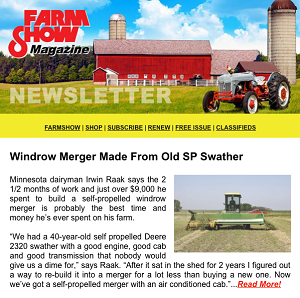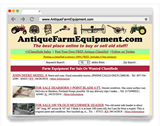2025 - Volume #49, Issue #5, Page #04
[ Sample Stories From This Issue | List of All Stories In This Issue | Print this story
| Read this issue]
HP Drive Rebuild Had Unforeseen Twists
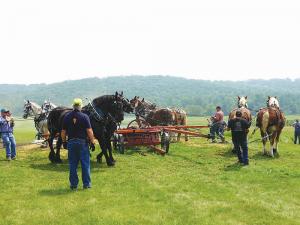 |
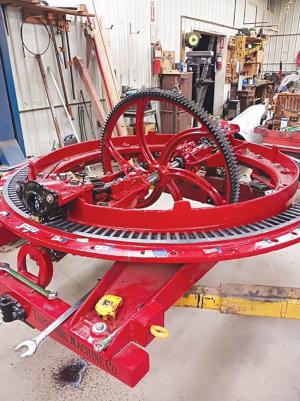 |
“It had been used pretty hard,” says McLaen. “Draft poles had broken or rotted off. Other parts had broken, and attempted repairs just made things worse. The drive keys in three of four gears on the main shaft and counter shaft were missing. It was being operated with one gear, instead of four, on top of the spur gear. The last time it was used, the main shaft and counter shaft twisted, which we didn’t realize until we started putting it back together.”
The Dingee-Woodbury Horse Power sweep unit was built by Case in the early 1900s to power large, stationary equipment, like Case threshing machines. This unit was sold to a Nebraska farmer around 1904. In 1976, it ended up at a threshing show in Minnesota. In the early 1990s, the Sodbusters bought it and moved it to Fort Ransom State Park in North Dakota, where it was part of demonstrations of old farm machinery.
With a penchant for mechanical challenges, McLaen brought the Dingee to his shop. Other members helped whenever they could, disassembling, painting and reassembling. New shafts were milled. An operator’s platform was recreated with new oak and more.
McLaen gives extra credit to Jim Rutland, who machined several parts, and to Jim Briden at Larson Welding, who made the shafts.
“No way could we have done it without them,” says McLaen, who dedicated hundreds of hours to the project himself.
As the group reassembled the machine, things often didn’t go right. They had no manual to turn to for answers, or so they thought.
“The only reference we found was ‘Science of Successful Threshing’ by Dingee-MacGregor, published by J.I. Case Threshing Machine Co. in 1904,” says McLaen. “It had only one chapter devoted to the horse power machine. I think I read it 20 times without understanding what I read.”
Part of the problem was the difference between the terms Dingee used and the common terms for the same thing today. Also, the way it was before disassembly was not necessarily the way it was supposed to be.
With all the parts laid out before him, McLaen found what he was searching for in the adjustments section of the chapter.
“Neatly tucked away in those few paragraphs was everything on how it was originally assembled,” says McLaen.
Once the machine was back together, McLaen made a tool to turn the main shaft by hand to check the gearing. The vital chapter in the book also aided in recreating the exact 12-ft., 8-in. length of the draft poles.
The machine was reinstalled at Fort Ransom and connected to a threshing machine. New draft poles were installed, horses were hitched up, and the gears started turning. It had been a year and a half since the task began, and more surprises were ahead.
“It took a few seconds to get the horses up to speed. The threshing machine was howling like a jet engine,” says McLaen. “A front axle broke off due to the stress. The desired speed of the input shaft was 230 rpm or 2.4 revolutions of the horses per min. When we counted, they were making 4.16 revolutions per minute for 416 rpm. It was running at twice the speed designed for.”
The issue was the size of the horses. When the machine was built, the horses were smaller, probably 1,300 to 1,500 lbs. Now, they weigh around 1,800 lbs. each.
“The shear mass pulling on the gears was probably 50% more than anticipated when the machine was built,” says McLaen.
The group’s solution was to reduce the output shaft speed by about 35% to match the desired threshing machine speed. While everything was soon working, one more change was needed.
“Jim Rutland pointed out that there was no shear pin in the entire works,” says McLaen. “That likely led to the twisting of the shafts. He went to a metal shop, and they devised a place for a shear pin at the output shaft. It has two holes, one for a 1/4-in. pin and one for a 5/16-in. if needed.”
The big question in his mind is what other surprises or discoveries are yet to be found.
Contact: FARM SHOW Followup, Fort Ransom Sodbusters Association, P.O. Box 56, Fort Ransom, N.D. 58033 (fortransomsodbusterassociation@gmail.com; www.fortransomsodbusters.com; www.facebook.com/SodbusterDays) or Dale McLaen, 13756 Hwy. 11, Rutland, N.D. 58067 (ph 701-678-5232).
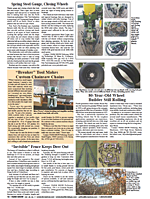
Click here to download page story appeared in.
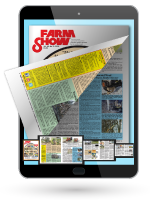
Click here to read entire issue
To read the rest of this story, download this issue below or click here to register with your account number.


